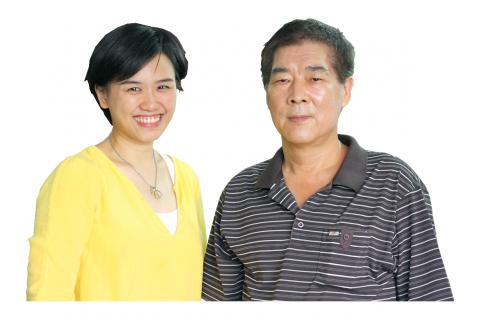When Lu Kuang-mao began an apprenticeship with a shoemaker more than three decades ago, it wasn’t because he was passionate about footwear. “I had to make money and eat,” says Lu, who grew up on a farm.
Since then, Lu has cultivated a reputation as one of Taiwan’s top traditional shoemakers. He estimates he has made tens of thousands of shoes over the course of his career and teaches at the Footwear and Recreation Technology Research Institute.
Hsing-ju Lin makes frequent trips to Lu’s workshop in Greater Taichung, and the two collaborate closely on each of Liebe Hsing’s designs. A new set of plastic lasts (forms in the shape of the foot) is made for each style. Lin carefully checks each new shipment from her leather suppliers, making sure that the animal skins used in her shoes are free from defects or flaws in the dye (sometimes as much as one-third of a hide is unusable). Many Liebe Hsing designs are made with delicate lambskin, which Lu stabilizes with an all-natural adhesive and stitches with thin nylon thread. The body of each shoe is carefully hammered to its sole; some are baked at low heat in an oven to mold the leather.

Photo: Catherine Shu, Taipei Times
Lu estimates that half of his students at the Footwear and Recreation Technology Research Institute hope to become shoe designers, while the other half plan to develop new shoe manufacturing technologies. Though traditional shoemaking skills are still being passed on to the next generation, Lu says small workshops like his are gradually disappearing as their owners retire.
“The construction of shoes is complicated and there are so many steps,” Lu says. “It sometimes takes the same amount of time to make 10 pairs of shoes by hand as it takes a factory to produce 100 pairs.”
For more information and a list of retailers, visit shoesologie.blogspot.com or www.facebook.com/pages/Liebe-Hsing. Liebe Hsing shoes are sold online at www.pinkoi.com/store/liebehsing

Exceptions to the rule are sometimes revealing. For a brief few years, there was an emerging ideological split between the Democratic Progressive Party (DPP) and Chinese Nationalist Party (KMT) that appeared to be pushing the DPP in a direction that would be considered more liberal, and the KMT more conservative. In the previous column, “The KMT-DPP’s bureaucrat-led developmental state” (Dec. 11, page 12), we examined how Taiwan’s democratic system developed, and how both the two main parties largely accepted a similar consensus on how Taiwan should be run domestically and did not split along the left-right lines more familiar in

As I finally slid into the warm embrace of the hot, clifftop pool, it was a serene moment of reflection. The sound of the river reflected off the cave walls, the white of our camping lights reflected off the dark, shimmering surface of the water, and I reflected on how fortunate I was to be here. After all, the beautiful walk through narrow canyons that had brought us here had been inaccessible for five years — and will be again soon. The day had started at the Huisun Forest Area (惠蓀林場), at the end of Nantou County Route 80, north and east

Specialty sandwiches loaded with the contents of an entire charcuterie board, overflowing with sauces, creams and all manner of creative add-ons, is perhaps one of the biggest global food trends of this year. From London to New York, lines form down the block for mortadella, burrata, pistachio and more stuffed between slices of fresh sourdough, rye or focaccia. To try the trend in Taipei, Munchies Mafia is for sure the spot — could this be the best sandwich in town? Carlos from Spain and Sergio from Mexico opened this spot just seven months ago. The two met working in the

This month the government ordered a one-year block of Xiaohongshu (小紅書) or Rednote, a Chinese social media platform with more than 3 million users in Taiwan. The government pointed to widespread fraud activity on the platform, along with cybersecurity failures. Officials said that they had reached out to the company and asked it to change. However, they received no response. The pro-China parties, the Chinese Nationalist Party (KMT) and Taiwan People’s Party (TPP), immediately swung into action, denouncing the ban as an attack on free speech. This “free speech” claim was then echoed by the People’s Republic of China (PRC),